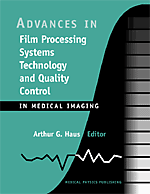
Advances in Film Processing Systems Technology and Quality Control in Medical Imaging
Author: Arthur G. HausISBN: 9781930524019
Published: 2001 | 245 pp. | Hardcover
OUT OF PRINT
Radiology | July 2002
"This book, which is based on a symposium held at the University of Rochester in October of 2000, presents the state-of-the-art in film processor technology, hard copy devices, and quality control. Although the advent of digital technology may appear to be making film obsolete, film will be with us for a while, and the subject matter of this book will remain relevant for the foreseeable future. The editor, Arthur G. Haus, is an eminent medical physicist with special expertise in x-ray film processors and quality control, which he derived from years of association with Kodak. Most of the contributors to this book are also well known in their own right and in the context of the American College of Radiology Mammography Accreditation Program.
"This book should be useful to most radiology professionals, particularly to personnel who work in mammographic quality control. The text is readable, the mathematics are at a minimum, and most of the material is appropriate for technologists and administrators. The book is organized into 13 chapters that address all aspects of processing, including historic aspects, quality control tests, equipment design, safety and environmental aspects, film processor performance assessment, dry image technology, roles of various personnel, and dark room design. It focuses mainly on mammography, which is appropriate because mammography presents the greatest challenges to processor technology, and it is one of few modalities that is still predominantly non-digital.
"While similar in scope to an existing book by Haus and Jaskulski (and some of the material has also appeared elsewhere), this book contains much new information. Chapter 2, titled Results of the Nationwide Evaluation of X-Ray Trends (NEXT) Surveys and Mammography Quality Standards Act (MQSA) Inspections, by Orhan Suleiman, will assist individual sites in bench-marking their performance. Chapter 7, by Gary Barnes, presents a systematic approach to assisting processor performance that will be useful to the MQSA physicist. Chapter 8, by R. Edward Hendrick, is an optimization of the processor and proposes the use of the 'gamma plot' as an alternative to the currently used contrast index in processor quality control programs. The gamma plot is described as providing a 'fingerprint' of processor performance, yielding valuable information without recourse to chemical analyses. This is how the state-of-the-art in quality control is advanced, and if evaluation studies confirm expectations, then one can expect adoption of the gamma plot method on a wide scale and possible incorporation into future regulatory standards.
"Chapter 11, on the role of the dealer in film processing, provides valuable insights for the radiology administrator who is negotiating a new film processor service contract. As dry image processing becomes more prevalent, chapters 10 and 11 present valuable material that is mostly unavailable in the usual textbooks on medical imaging. While a number of authors represent a single manufacturer, the editor has gone out of his way to ensure that the book presents a balanced picture. Chapter 14, on dark room design, contains much practical information for the medical physicist.
"The coverage on film processors and hard copy devices in most textbooks tends to be perfunctory, and this book fills that void. The reasonably priced and attractively produced book resembles the already mentioned book by Haus and Jaskulski, which was aimed at technologists and medical physicists, whereas the present book will have a broader appeal. This book warrants a place in the medical physicist's library, and mammography sections should consider obtaining it for the benefit of their technologists. Radiologists and administrators involved in quality control programs will also find this book useful."
Dev Chakraborty, PhD


